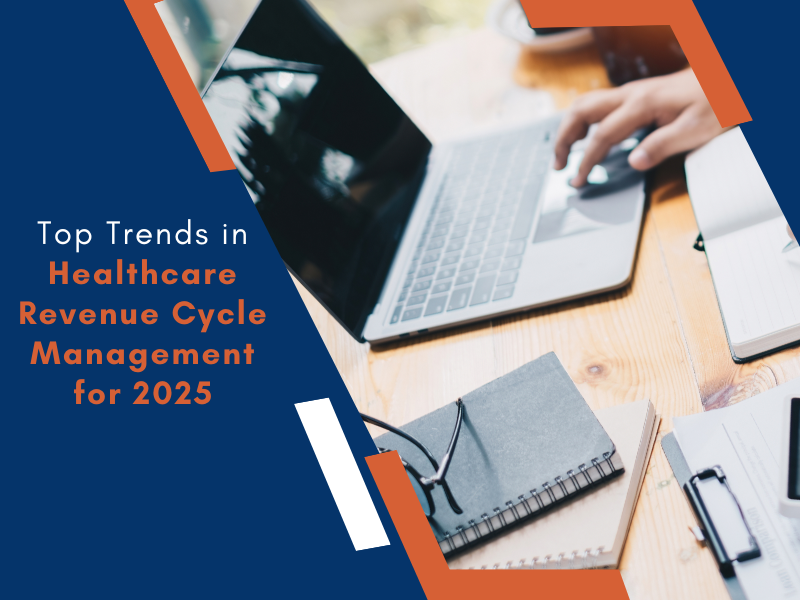Healthcare revenue cycle management (RCM) is the backbone of financial operations within healthcare organizations. As we look ahead to 2025, this critical aspect of healthcare management is evolving rapidly due to changing technologies, regulations, and patient expectations. Healthcare revenue cycle management ensures that healthcare providers are reimbursed for the services they provide, making it an essential component of any healthcare facility’s operations.
The trends emerging in RCM for 2025 reflect an ever-growing focus on technology, patient-centric services, and efficiency. Below, we’ll explore the top trends that will shape the future of healthcare revenue cycle management.
1. Artificial Intelligence (AI) and Automation in RCM
One of the most significant changes in healthcare revenue cycle management for 2025 is the integration of artificial intelligence (AI) and automation. These technologies help streamline repetitive tasks, reduce human errors, and speed up billing processes.
AI is being used to assist in coding, claims management, and denial prevention. It can quickly analyze medical records and suggest the most accurate coding, reducing the risk of coding errors and improving the overall accuracy of claims. Automation in claims submission, payment posting, and patient billing is also becoming more prevalent. These tools allow healthcare providers to process large volumes of claims faster, ensuring quicker reimbursement and fewer delays.
For healthcare organizations, this means more time spent on patient care and less time spent on administrative tasks. AI and automation will be indispensable in improving the efficiency of the healthcare revenue cycle management process.
2. Value-Based Care and Payment Models
With the rise of value-based care (VBC), healthcare providers are increasingly being compensated based on the quality of care provided, rather than the volume of services. This shift in payment models has a significant impact on healthcare revenue cycle management.
Healthcare organizations will need to adjust their RCM processes to accommodate value-based reimbursement. This includes a greater focus on patient outcomes, preventative care, and long-term health management. Revenue cycle management systems must be agile enough to handle the complexities of VBC models, which require accurate tracking of patient care outcomes and adherence to care protocols.
The transition to value-based care is expected to be one of the most significant changes in the healthcare industry over the next several years. As we move into 2025, healthcare providers will need to develop robust RCM solutions that can support the new payment models and ensure the financial sustainability of their organizations.
3. Patient-Centric Revenue Cycle Management
Patient expectations are evolving, and healthcare organizations are adapting by implementing more patient-centric revenue cycle management practices. This includes providing patients with greater transparency, accessibility, and control over their healthcare bills.
In 2025, patients will demand more detailed, easy-to-understand billing statements and better communication regarding their insurance coverage and out-of-pocket costs. Patients are also looking for more flexibility in payment options, such as payment plans or digital wallets.
As a result, healthcare organizations are investing in tools that provide patients with a clearer understanding of their financial responsibilities. This includes patient portals, online payment options, and mobile apps that allow patients to view their bills, make payments, and communicate with billing teams in real time.
Patient satisfaction will continue to be an essential part of healthcare revenue cycle management. By focusing on the patient experience, healthcare organizations can reduce confusion and frustration, which can ultimately lead to improved collections and better patient outcomes.
4. Healthcare Data Analytics
Healthcare data analytics plays an increasingly crucial role in healthcare revenue cycle management. By analyzing large volumes of patient data, healthcare providers can gain valuable insights into their financial operations, helping them identify inefficiencies and areas for improvement.
In 2025, healthcare organizations will continue to invest in data analytics tools to enhance decision-making within their revenue cycle. These tools can help identify patterns in claim denials, track reimbursement trends, and forecast future revenue more accurately. They can also be used to monitor the effectiveness of various RCM processes and make data-driven decisions to optimize cash flow and improve financial performance.
As healthcare becomes more data-driven, organizations that invest in advanced analytics will have a competitive advantage in optimizing their revenue cycle management processes.
5. Telehealth and Remote Patient Care
Telehealth and remote patient care services have become more popular in recent years, and this trend will continue to grow in 2025. As more patients seek care through virtual visits and telemedicine platforms, healthcare organizations will need to adapt their revenue cycle management processes to accommodate these services.
Billing for telehealth services requires different coding, reimbursement models, and billing processes compared to in-person visits. For example, some insurance providers have different policies for reimbursing telehealth services, which may require additional steps in the claims submission process.
To streamline RCM for telehealth, healthcare providers will need to implement billing systems that are capable of handling virtual care services and ensuring accurate reimbursement. Telehealth-related revenue cycle management is expected to become a key focus for healthcare organizations in 2025.
6. Blockchain for Secure and Efficient Claims Processing
Blockchain technology is gaining traction in healthcare, and its potential applications in healthcare revenue cycle management are vast. By leveraging blockchain’s ability to securely store and share data across a distributed ledger, healthcare organizations can ensure the integrity of claims data and reduce the potential for fraud.
In 2025, we can expect blockchain to play a larger role in healthcare revenue cycle management by simplifying the claims process. For example, blockchain can help improve the accuracy and speed of claims processing by providing a transparent, tamper-proof record of claims data. This will make it easier for healthcare providers and payers to resolve disputes and reduce errors in the billing process.
Blockchain technology has the potential to revolutionize healthcare revenue cycle management by ensuring data security and enhancing efficiency. While its widespread adoption may take some time, the groundwork for blockchain in RCM is already being laid.
7. Regulatory Changes and Compliance
The healthcare industry is highly regulated, and RCM practices must comply with various federal and state regulations. In 2025, healthcare providers will face new and evolving regulations that will impact revenue cycle management processes.
For example, recent changes to the Centers for Medicare & Medicaid Services (CMS) regulations, as well as the implementation of the No Surprises Act, will require healthcare organizations to adjust their billing practices. These regulations are designed to protect patients from unexpected medical bills, and healthcare providers must ensure that their billing practices align with these new rules.
Staying compliant with evolving regulations is a top priority for healthcare organizations in 2025. RCM solutions will need to be adaptable to accommodate new regulations and ensure that healthcare providers remain in good standing with regulatory bodies.
8. Outsourcing RCM Services
As healthcare organizations continue to face financial pressures and staffing shortages, outsourcing healthcare revenue cycle management services is becoming an increasingly popular option. By outsourcing RCM tasks to specialized companies, healthcare providers can reduce overhead costs, improve efficiency, and focus more on patient care.
Outsourcing RCM allows healthcare organizations to leverage the expertise and advanced technologies of specialized providers. These companies are often more adept at managing the complexities of healthcare billing and coding, ensuring that healthcare organizations can achieve better reimbursement rates and minimize denials.
In 2025, outsourcing healthcare revenue cycle management will become a common strategy for healthcare organizations looking to optimize their financial operations.
Conclusion: Embrace the Future of Healthcare Revenue Cycle Management with Apaana Healthcare
As we approach 2025, the healthcare industry is undergoing rapid transformation, and healthcare revenue cycle management is no exception. From the integration of AI and automation to the shift toward value-based care and telehealth, healthcare organizations will need to adapt to these evolving trends to stay competitive and financially sustainable.
At Apaana Healthcare, we are at the forefront of these trends, driving operational excellence with our global healthcare management solutions. We specialize in outsourced services for health plans, including member enrollment, claims administration, medical billing and coding, and provider engagement. Our cost-effective solutions ensure that our clients can focus on what matters most – delivering high-quality patient care while achieving financial success.
With Apaana Healthcare, you can trust that your revenue cycle management will be handled with expertise and efficiency, so you can stay ahead in this ever-changing landscape. Let us help you navigate the future of healthcare revenue cycle management.





